The ‘80s in 40: ‘Porky’s’ (March 21, 1982)
Bob Clark's raunchy film ushered in a wave of copycat teen comedies and, with it, a lot of mixed messages.
The ’80s in 40 revisits the decade of the 1980s choosing four movies a year, one from each quarter. This entry covers the first quarter of 1982.
In retrospect, it seems like it ought to have been easy to predict Porky’s would become a phenomenon. If anything, it ought to be surprising that four years divided 1978’s Animal House and Bob Clark’s film, which went into wide release in March 1982 after a test run in a few cities the previous year.* The combination of hijinks, raunch, and nostalgia isn’t the hardest formula to replicate on a limited budget, and a marketing campaign that sold the promise of abundant nudity could put it over the top. Yet it took Porky’s to show the way, in the process becoming, for a while, the most financially successful comedy of all time. Why didn’t anyone make this sort of crass commercial calculation before?
But here’s an odd detail about Porky’s: it wasn’t a crass commercial calculation at all. It was closer to a passion project. Clark had been working on the film on and off since 1972 and writing the script even forced him to perform the filmmaking equivalent of playing through the pain. Stricken with mononucleosis in the summer of 1979, he recorded the story on cassette tapes that he then handed over to Roger Swaybill to shape into a script. (Clark is the film’s only credited screenwriter due to the restrictions of Canadian production. Swaybill is listed as an “advisor.”) “I was weeping with laughter,” Swaybill told the Los Angeles Times in 1985. “About an hour into the original narrative, I became convinced that I was sharing in the birth of a major moment in movie history.”
Clark’s career to that point had been a steady climb toward respectability. After moving to Canada in the early 1970s, he’d worked his way up through horror movies to action films to genuinely prestigious films like Murder by Decree and Tribute. But he wanted to tell a personal story, even if said personal story involved a bunch of horny teens in the Eisenhower era. For Porky’s, he drew on his memories growing up in Ft. Lauderdale, Florida, where he spent his teen years.
“Actually, I think Porky’s is a mythological descendent of Huck Finn and Tom Sawyer,” Clark told UPI a few week’s after the film’s release, when some outlets began trying to figure out why it had become such a hit. “Bawdy and earthy as it is, entire families are going to see my picture because they recognize the truth. People can identify with what’s happening on screen because it’s not very different from what’s going on in every neighborhood.”
That’s a lot to hang on a film whose most memorable scene climaxes with a teenage kid having his penis yanked by a sadistic gym teacher after exposing himself through a peephole to a bunch of showering classmates.
When I wrote a short history of Porky’s a couple of years ago as part of a package of pieces on movie comedy history, I hadn’t watched the film in years and treated it with a bit of a shrug. Porky’s is, put simply, not a very good movie, and I say this as someone who admires some of Clark’s other films quite a bit. (Not Baby Geniuses. I’ve never seen that one.) As a comedy, it kind of slouches along from one poorly timed comic set piece to the next, none of which are all that funny.
Case in point: the scene in which the aforementioned gym teacher, Beulah Ballbricker (Nancy Parsons) attempts to make a case for employing some unusual investigative techniques in identifying the peephole perpetrator who slipped away from her grasp. As the scene goes on, the supporting characters can’t control their laughter as they sit beneath a Norman Rockwell painting of Dwight D. Eisenhower. Maybe this brought down the house when it played theatrically. Watched now, it feels like the cinematic equivalent of a flashing sign prompting a studio audience to laugh.
Ultimately, however, it’s too odd a film to bat away as merely an artifact of ’80s moviegoers’ bad taste, and that Dwight D. Eisenhower portrait points to why. “It’s a bright, beautiful spring day,” an Angel Beach, Florida DJ tells his morning listeners in the film’s opening scene. “President Eisenhower is running a right ship, hand steady on the helm. The stars are secure in the firmament and the rent’s paid for the month, so all’s right with the world.” It’s never clear how much irony we’re supposed to read into this.
Some at least: Clark fills Porky’s with details of early 1950s America but also keeps returning to a subplot in which the bigoted Tim (Cyril O’Reilly) abuses then befriends Brian (Scott Colomby), a Jewish transfer student. The mixed feelings make sense. Clark clearly loves the era, treating it with the same fondness for the past he’d bring to A Christmas Story a few years later. But he’s also remembering a place that, as he’d recall, used to hang “No Jews Allowed” signs on the beach.
From there, it gets more complicated. Tim’s friends look down on him as a redneck, in part because of his racism. He’s introduced using a racial slur. His friends quickly upbraid him for this, but it’s in the context of their attempt to hire a Black man to scare some of their friends during a visit to a sex worker named Cherry Forever (Susan Clark). The girls aren’t really judged for their interest in sex but none of them demonstrate much in the way of an inner life, either. The film seems to see that peeping scene as an act on the far fringes of acceptable behavior rather than a violation. The villainous Porky (Chuck Mitchell) runs a roadhouse decked out in Confederate flags, but he becomes the boys’ enemy after taking their money under the false pretense he’d provide some of his dancers for sex. Tim eventually tells off his abusive dad (yay!) by telling him “If being a man means being what you are, I’d rather be queer.” (Um…) Some movies send mixed signals. Porky’s projects a moral worldview that’s all static and pops.
This was probably the last thing on the minds of moviegoers in 1982, though not critics. “Let me tell you my reaction to this vulgar, sexist, racist, sadistic, juvenile, scatological, gross movie. Hold your ears,” John Stark wrote in his one-star review for the San Francisco Examiner above a full-paragraph attempting to convey a scream. But it’s hard to figure out the level of self-awareness at work in Porky’s scenes of sadism, vulgarity, sexism, and racism. Is the fact that we see only one Black character of any consequence and he has to be sought out by protagonists who attend a conspicuously all-white school an example of the film being racist or commenting on racism? At what point does its depiction of boys (and grown men) in a constant state of arousal stop being sexist and start being parodic?
I don’t have an answer, but I wonder about the confusion’s lasting effect on ’80s movie culture, and beyond. It depicts a world in which violations of consent are to be expected and laughed away. Here, that behavior is largely limited to the shower scene, but it’s a notion other films, most notably Revenge of the Nerds, would take to some pretty dark places. Porky’s does at least look thoughtful in comparison to the many imitators that followed, a geyser of titillation that arrived in theaters between 1982 and 1985 with names like Joysticks and Screwballs then lived on in video stores and cable. As confused and contradictory as the film can be, it has something on its mind beyond serving as a nudity delivery system.
I also can’t tell you to what extent a movie like Porky’s creates cultural attitudes versus reflecting it. But I do know it’s a movie every boy (and, undoubtedly, many girls, too) of my generation watched. I heard its most quotable lines (“What do you use for a jockstrap, kid? A peanut shell and a rubber band?,” etc.) long before I watched it. Its nude scenes were the talk of my junior high. It was a core sex ed text for those of a certain age. I’m not sure anyone seeks it out now or if it had any kind of shelf life beyond Generation X but, in its era, it was a blockbuster. Which raises another question: even if Porky’s most lasting contribution is to have carved out a space for raunch that other ’80s comedies rushed to fill, would any sort of flesh-filled comedy have done the trick if they’d beaten Porky’s to theaters? It’s a question without an answer. This is the one we got and the one with which we have to reckon.
Next: Poltergeist
Body Heat (August 1981)
Stripes (June 1981)
Heaven's Gate (April 1981)
Cutter’s Way (March 1981)
9 to 5 (December 1980)=
Ordinary People (September 1980)
Urban Cowboy (June 1980)
Little Darlings (March 1980)
* That makes its placement here a little questionable, honestly, but let’s go with it.







Porky's was the first movie my wife and I watched together, when we met in college. Twenty years later it remains the worst movie we've watched together.
I had planned to go my whole life without ever seeing this (born 1980, so too young for the initial run), but I ended up watching it last year. Somewhere between a rewatch of "Black Christmas" and the Unspooled episode on "A Christmas Story", I learned that it was a Bob Clark movie.
I always assumed it was just a cruder version of Animal House (I think I may have seen a piece of the shower-peeping scene, long ago, likely on TV, so edited), so I was surprised to learn it was a high school movie, which I think takes a lot of the edge off. Teenage boys are really stupid!
Anyway, my expectations set low, I found it surprisingly watchable. The nudity is pretty equitable (this may be an artifact of Amazon Prime having the open-matte version). The only sex scene is between adults (Kim Cattrall!!). The boys are usually the victims of their own ignorance about sex while the girls, while obviously not the focus, come across as witty and mature.
And I swear, Nancy Parsons turns in a Margaret Dumont caliber performance of playing straight while everyone around her is being extremely silly, especially in the "penis lineup" scene.